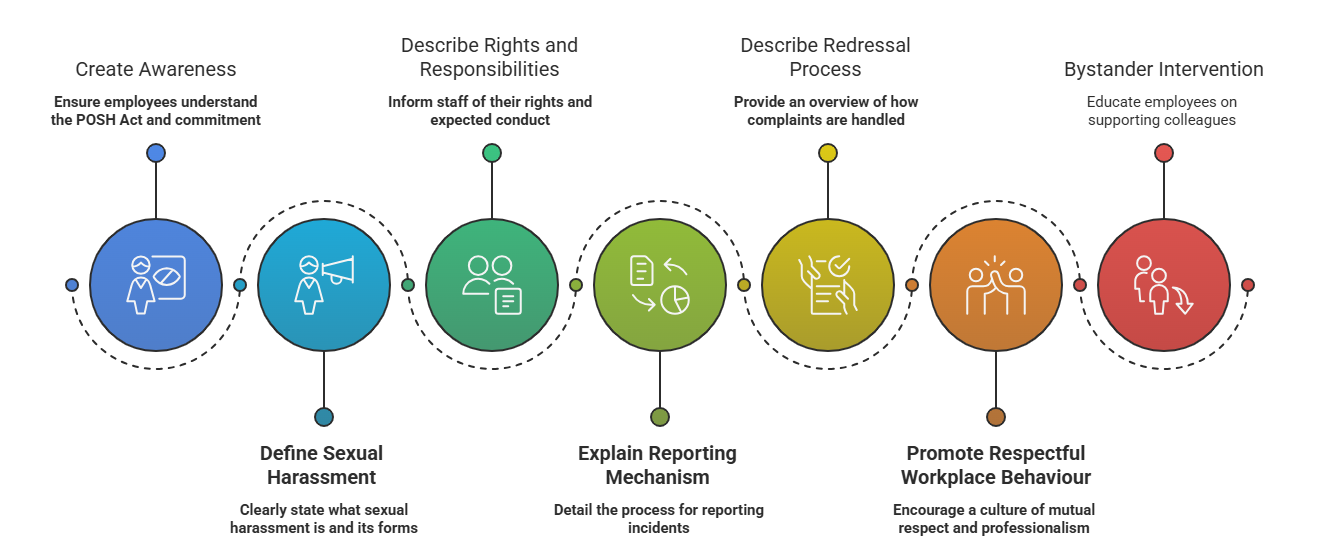What is POSH Awareness Training Program?
POSH (Prevention of Sexual Harassment) awareness training program for employees is an educational initiative designed to inform all staff members within an organization about the Sexual Harassment of Women at Workplace (Prevention, Prohibition and Redressal) Act, 2013 (and similar legislation in other regions).
The primary goals of these programs are to
- Create Awareness: Ensure all employees understand the existence and importance of the POSH Act and the organization's commitment to preventing sexual harassment.
- Define Sexual Harassment: Clearly state what sexual harassment is and its different manifestations, such as unwanted comments, physical touch, and nonverbal behavior. This aids workers in recognizing improper conduct.
- Describe Rights and Responsibilities: Inform staff members of their POSH Act rights, such as the right to a safe workplace and the procedure for filing incident reports. It also makes clear what each employee is expected to do to keep the workplace civil.
- Explain the Reporting Mechanism: Detail the step-by-step process for reporting incidents of sexual harassment within the organization, including who to contact (often the Internal Committee or a designated person) and how the complaint will be handled.
- Describe the Redressal Process: Provide an overview of how complaints are inquired into and the potential outcomes or actions that may be taken.
- Promote Respectful Workplace Behaviour: Go beyond just defining illegal behaviour and encourage a culture of mutual respect, dignity, and professionalism among all employees.
- Bystander Intervention: In some programs, employees may also be educated on the importance of bystander intervention and how they can safely support colleagues who may be experiencing harassment.

Objectives of POSH Awareness Program
In essence, a POSH awareness training program aims to create an informed and sensitized workforce that understands what sexual harassment is, how to prevent it, and what to do if it occurs, contributing to a safer and more respectful work environment for everyone.
- Clear Definition of Work Place.
- Educate employees regarding their entitlements and responsibilities as outlined in the Act.
- Detail the established steps for reporting instances of harassment.
- Offer foundational knowledge of the process for resolving complaints.
- Nurture a workplace ethos characterized by respect, dignity, and inclusivity.
- Elucidate the part every employee plays in maintaining a secure and harassment-free setting.
- Instil trust in the organization's commitment to addressing harassment matters effectively.
- Promote a healthy and efficient organizational atmosphere.
Understanding the Scope and Applicability of the POSH Act, 2013
- Introduction to the POSH Act 2013
- Background and objectives of the legislation.
- Importance of preventing sexual harassment at the workplace.
- Understanding the legal framework in India.
- Defining Sexual Harassment
- Comprehensive explanation of what constitutes sexual harassment according to the Act.
- Different forms of sexual harassment: physical, verbal, non-verbal, visual, and digital.
- Illustrative examples and scenarios to ensure clarity.
- Emphasis on the "unwelcome" nature of the behaviour.
- Rights and Responsibilities of Employees
- Understanding the right to a safe and harassment-free workplace.
- Responsibilities of all employees in maintaining a respectful environment.
- Importance of bystander intervention (if applicable in the program).
- Reporting Mechanisms and Complaint Procedure
- Step-by-step process for reporting incidents of sexual harassment.
- Details about the Internal Committee (IC) and who to contact.
- Importance of confidentiality and non-retaliation.
- Timeline for filing a complaint.
- Overview of how complaints are inquired into by the IC.
- Potential outcomes and actions that can be taken.
- Support available to the complainant.
- Consequences of Sexual Harassment
- Impact on the individual (emotional, psychological, professional).
- Impact on the organization (reputation, productivity, legal implications).
- Promoting Respectful Workplace Conduct
- Emphasis on professional behavior and communication.
- Understanding boundaries and consent.
- Importance of inclusivity and diversity.

